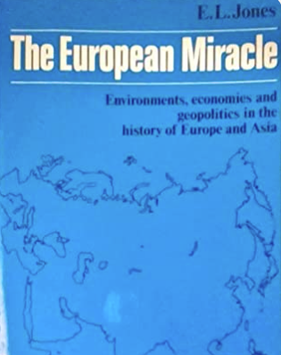
Summary
The European Miracle: Environments, Economies and Geopolitics in the History of Europe and Asia is a book written by Eric Jones in 1981 to refer to the sudden rise of Europe during the Late Middle Ages. Ahead of the Islamic and Chinese civilizations, Europe steadily rose since the early modern period to a complete domination of world trade and politics that remained unchallenged until the early 20th century.
 | |
| Author | Eric Jones |
|---|---|
| Country | Australia |
| Language | English |
| Genre | history, economic theory |
| Publisher | Cambridge University Press |
Publication date | 1981 |
| Media type | Hardback |
| Followed by | Growth Recurring: Economic Change and World History |
This process started with the first European contacts and subsequent colonization of great expanses of the world. The Industrial Revolution further reinforced it.
Jones's book gave rise to the term European miracle. It is closely related to the idea of the Great Divergence, but the latter's focuses, rather than the origins of the rise of Europe during the Renaissance, is the 18th-century culmination of the process and the subsequent "imperial century" of Britain.
Summary edit
Jones aims to explain why did modern states and economies developed first in the peripheral and late-coming culture of Europe. He attempts to argue a concatenation of various factors, in particular the interplay of natural and economic factors that has worked to Europe's advantage and to the disadvantage of its Asian competitors.
The European miracle theory purports that the European nuclear family, with women marrying late and having few children, Europe's population was better controlled than in the rest of the world, which "multiplied insensately."[1] Europe was thus not vulnerable to Malthusian Crises and so could form a progressive capitalist society.
Urbanization is also adduced as a factor. Crucially, the cities were also semi-autonomous, especially the Italian city-states. The growth of banking, accounting and general financial infrastructure in such cities is seen as unique and vital to the rise of Europe.
Reception edit
Jones's study is one of the most influential books dedicated to the question of European exceptionalism. Some historians, in particular of the "California school", have felt that Jones overstated the degree of difference between Europe and non-European regions on the eve of the Industrial Revolution.[citation needed]
The attention attracted by the book has also resulted in it being described by the American historian Joel Mokyr as "the whipping boy of those who have resented what they viewed as historiographical triumphalism, eurocentricity, and even racism."[2] It has been attacked by thinkers such as James Blaut, Andre Gunder Frank, Kenneth Pomeranz, and John M. Hobson. They accuse Jones of Eurocentrism and "cultural racism" (Blaut's term[3]).
See also edit
Editions edit
- Jones, Eric (1981). The European Miracle: Environments, Economies and Geopolitics in the History of Europe and Asia. Cambridge University Press. ISBN 978-0-521-52783-5.
- Jones, Eric (1987). The European Miracle: Environments, Economies and Geopolitics in the History of Europe and Asia. Cambridge University Press. ISBN 978-0-521-33670-3.
- Jones, Eric (2003). The European Miracle: Environments, Economies and Geopolitics in the History of Europe and Asia. Cambridge University Press. ISBN 978-0-521-52783-5.
References edit
- ^ The European Miracle: Environments, Economies and Geopolitics in the History of Europe and Asia, 2nd Edition, Cambridge UP, p. 6
- ^ Mokyr, Joel (2002). The Enduring Riddle of the European Miracle (PDF). Retrieved October 27, 2011.
- ^ Blaut, James Morris (1993), The colonizer's model of the world: geographical diffusionism and Eurocentric history, New York, NY: The Guilford Press, p. 64, ISBN 9780898623482
Further reading edit
- Blaut, James (2000). Eight Eurocentric Historians. ISBN 978-1-57230-591-5.
- Blaut, James (1993). The Colonizer's Model of the World. ISBN 978-0-89862-348-2.
- Farmer, Paul (2003). Pathologies of Power: Health, Human Rights, and the New War on the Poor. ISBN 978-0-520-23550-2.
- Frank, Andre (1998). Reorient: Global Economy in the Asian Age. ISBN 978-0-520-21474-3.
- Hobson, John M. (2004). The Eastern Origins of Western Civilisation. Cambridge University Press. ISBN 9780521547246.
- Pomeranz, Kenneth (2001). Great Divergence: China, Europe, and the Making of the Modern World Economy. ISBN 978-0-691-09010-8.
- Kennedy, Paul (1988). The Rise and Fall of the Great Powers. ISBN 978-0-679-72019-5.


